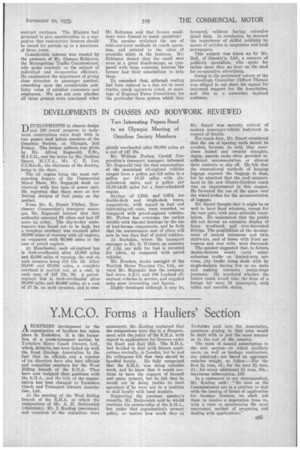DEVELOPMENTS IN CHASSIS AND BODYWORK, REVIEWED
Page 85

If you've noticed an error in this article please click here to report it so we can fix it.
Two Interesting Papers Read to an Olympia Meeting of Omnibus Society Members DEVELOPMENTS In chassis design and 100 years' progress in bodywork construction were dealt with in two papers read before members of the Omnibus Society, at Olympia, last Friday. The former address was given by Mr. Alfred Regnauld, B.Sc., M.I.E.E., and the latter by Mr. Godfrey Smart, M.I.T.A., Mr. C. E. Lee, C.I.Mar.E., the chairman of the Society, being in the chair.
The oil engine being the most outstanding feature of the Commercial Motor Show, Mr. Regnauld dealt extensively with this type of power unit. He regretted that there were so few British designs of fuel pump on the market.
From Mr. R. Stuart Filcher, Manchester Corporation's transport manager, Mr. Regnauld learned that that authority operated 98 oilers and had 57 more on order. The day-to-day maintenance was found not to be high, but a complete overhaul was required after 30,000 miles of running with oil engines, as compared with 60,000 miles in the case of petrol engines.
At Manchester, each oil-ngined bns is dock-overhauled after 15,000 miles and 45,000 miles of running, the cost. on each occasion being 114 15s, 3d. After 30,000 and 60,000 miles, a complete overhaul is carried out, at a cost, in each case, of £47 18s. 9d. A petrolengined buc is dock-overhauled after 20,000 miles and 40,000 miles, at a cost of £7 2s. on each occasion, and is corn pletely overhauled after 60,000 miles at a cost of £47 18s.
Mr. William Forbes, Cardiff Corporation's transport manager, informed Mr. Regna aid that the fuel consumption of the municipal oil-engined vehicles ranged from a gallon per 8.6 miles to a gallon per 10.19 miles with sixcylindered emits, and a gallon per 13.36-14.65 miles for a four-cylinderecl engine.
Savings of 1.56d. and 1.67d. for double-deck and single-deck buses, respectively, with regard to fuel and lubricating-oil costs, were recorded, as compared with petrol-engined vehicles. Mr. Forbes has overcome the earlier trouble with big-end bearings by the use of lead-bronze components, and he feels that the maintenance cost of oilers will now be less than that of petrol vehicles.
At Rochdale, where the transport manager is Mr. G. Webster, an economy of 1.8d. per mile for fuel is recorded for oilers, as compared with petrol vehicles.
Mr. Bracken, works manAger of the Scottish Motor Traction Co., Ltd., advised Mr. Regnauld that the eompany bad seven A.E.C. and 104 Leyland oilengined vehicles in service, and supplied some most interesting cost figures.
Highly developed although it may be, Mr. Smart was severely critical of modern passenger-vehicle bodywork in respect of details.
For coach duty, Mr. Smart considered that the use of opening roofs should be avoided, because, he said, they sometimes leaked and created draughts. Again, parcels racks often provided insufficient accommodation or allowed their contents to slip oft. He felt that the conventional methods of housing luggage exposed the baggage to dust, but he admitted that the roof compartment in the new Gloster-Gardner coach was an improvement in this respect. He favoured the use of the space over the wheel-arches for the accommodation of luggage.
Mr. Smart thought that it might be as well to have fixed windows, except for the rear pair, with more scientific ventilation. He maintained that the public did not favour an excessive display of fancy woodwork and over-decorated fittings. The possibilities of the development of central entrances and twin stairways, and of buses with front entrances and rear exits, were dismissed.
The speaker suggested that, in future, doubleeleekers would carry outersuburban traffic on limited-stop services, city traffic being dealt with by single-deckers having few orno seats and making intensive penny-stage journeys. He wondered whether the future coach would take the form of a lounge for some 24 passengers, with tables and movable chairs.




























































































































